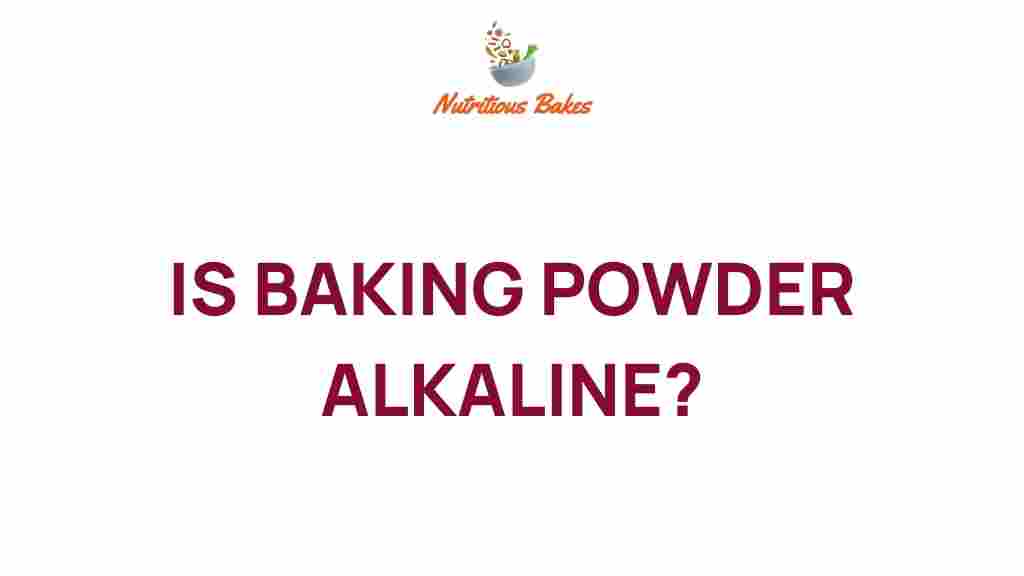Unveiling the Alkaline Mystery of Baking Powder
Baking powder is an essential ingredient in baking, playing a crucial role in the leavening of baked goods. Understanding the alkaline properties of baking powder and its relationship with acidity can enhance your cooking science knowledge, improve your culinary skills, and help you achieve perfect results every time. In this article, we will delve into the fascinating world of baking powder, examining its ingredient properties, the science behind its function, and offering valuable culinary tips for home bakers.
The Chemistry of Baking Powder
Baking powder is a chemical leavening agent that combines an acid and a base, along with a filler to keep the two components dry. This mixture can be categorized as either single-acting or double-acting:
- Single-acting baking powder: This type releases carbon dioxide when it comes into contact with moisture. Thus, it must be baked immediately after mixing.
- Double-acting baking powder: This type contains two acids, one that reacts at room temperature and one that reacts when heated. This allows for a more flexible timing in the baking process.
The alkaline nature of baking powder is critical because, in the presence of moisture and heat, it reacts to produce carbon dioxide gas. This gas forms bubbles in the batter or dough, causing it to rise and become light and airy.
Ingredient Properties
Understanding the individual components of baking powder can help you make informed choices in your baking endeavors:
- Sodium bicarbonate (baking soda): This alkaline component reacts with acidic ingredients (like yogurt or vinegar) to produce carbon dioxide.
- Acidic component: This can be cream of tartar or another acid that reacts with sodium bicarbonate to create the leavening effect.
- Filler: Commonly cornstarch, this ingredient prevents clumping and prolongs shelf life.
The Role of Acidity
The balance of acidity and alkalinity in your recipes is crucial. If your recipe includes acidic ingredients, the baking powder will react with these to produce carbon dioxide. Conversely, if your recipe is too alkaline, you may not get the desired rise or texture.
Here are some common acidic ingredients and how they interact with baking powder:
- Buttermilk: Its acidity activates baking powder and enhances flavor.
- Vinegar: Often used in cakes, it creates a strong reaction with baking soda.
- Yogurt: Similar to buttermilk, it adds moisture and acidity.
Culinary Tips for Using Baking Powder
To ensure your baked goods turn out perfectly, here are some culinary tips:
- Check freshness: Baking powder has a shelf life, so always check the expiration date. To test, add a teaspoon of baking powder to warm water; if it bubbles vigorously, it’s still active.
- Measure accurately: Use a dry measuring cup and level it off for precise measurements.
- Mix dry ingredients: Combine baking powder with flour before adding wet ingredients to ensure even distribution.
- Don’t overmix: Once you add baking powder, mix just until combined to prevent deflation.
Step-by-Step Process for Perfect Baking
To achieve success in baking with baking powder, follow these steps:
- Gather your ingredients: Ensure you have all necessary ingredients, including baking powder, flour, and any acidic components.
- Preheat your oven: Set your oven to the required temperature before you start mixing your batter.
- Mix dry ingredients: Combine flour, baking powder, and any other dry ingredients in a bowl.
- Combine wet ingredients: In a separate bowl, mix your wet ingredients, including any acidic ingredients.
- Combine wet and dry mixtures: Pour the wet mixture into the dry ingredients and stir gently until just combined.
- Pour into the baking pan: Transfer your batter to the prepared baking pan and smooth the top.
- Bake immediately: Place in the preheated oven and bake according to your recipe’s instructions.
Troubleshooting Common Baking Powder Issues
Even with the best intentions, baking can sometimes go awry. Here are some common issues and how to troubleshoot them:
- Flat cake: This can happen if your baking powder is expired or if it was not mixed properly with dry ingredients.
- Too dense: If your batter is too thick, try adding a little more liquid or ensure that your baking powder is fresh.
- Overly risen: If your baked goods have a dome shape, it could be a sign of too much baking powder or not enough mixing.
Food Chemistry and Baking Powder
The science of food chemistry explains how baking powder interacts with other ingredients. The reaction that occurs when baking powder is mixed with wet ingredients leads to the production of carbon dioxide gas, which is essential for leavening. This process can be broken down into chemical reactions:
- Acid-base reaction: The alkaline baking powder reacts with acidic components to release carbon dioxide.
- Heat activation: The heat from the oven accelerates these reactions, leading to the rapid expansion of gas bubbles.
Understanding these reactions can help bakers tweak recipes for different results, such as creating lighter cakes or denser breads.
Conclusion
In summary, baking powder is a crucial ingredient in baking that combines the science of acidity and alkalinity to create delicious, fluffy baked goods. Its unique properties can transform your culinary creations if used correctly. By mastering the basics of baking powder, understanding its chemistry, and applying effective culinary tips, you can take your baking skills to the next level.
For further reading on baking essentials, check out this comprehensive guide on baking techniques. And don’t forget to explore the fascinating world of food chemistry to enhance your understanding of why baking powder works the way it does.
Happy baking!
This article is in the category Ingredients and created by NutritiousBakes Team
